Investigating Friction and Antiwear Characteristics of Organic and Synthetic Oils Using h-BN Nanoparticle Additives: A Tribological Study
Abstract
:1. Introduction
2. Materials and Methods
2.1. Materials and Preparation of Nanolubricants
2.2. Characterization of Nanoparticles
3. Experimental Procedure
4. Results and Discussion
4.1. Rheological Measurements of Nanolubricants
4.2. Tribological Investigation
Antiwear Properties
5. Conclusions
Author Contributions
Funding
Data Availability Statement
Conflicts of Interest
References
- Akbulut, M. Nanoparticle-Based Lubrication Systems. J. Powder Met. Min. 2012, 1, e101. [Google Scholar] [CrossRef]
- Jost, H.P. Lubrication: Tribology; Education and Research; Report on the Present Position and Industry’s Needs (Submitted to the Department of Education and Science by the Lubrication Engineering and Research) Working Group; HM Stationery Office: Richmond, UK, 1966. [Google Scholar]
- Rawat, S.S.; Harsha, A.P.; Das, S.; Deepak, A.P. Effect of CuO and ZnO nano-additives on the tribological performance of paraffin oil–based lithium grease. Tribol. Trans. 2019, 63, 90–100. [Google Scholar] [CrossRef]
- Cursaru, D.-L.; Andronescu, C.; Pirvu, C.; Ripeanu, R. The efficiency of Co-based single-wall carbon nanotubes (SWNTs) as an AW/EP additive for mineral base oils. Wear 2012, 290–291, 133–139. [Google Scholar] [CrossRef]
- Adhvaryu, A.; Erhan, S.; Perez, J. Tribological studies of thermally and chemically modified vegetable oils for use as environmentally friendly lubricants. Wear 2004, 257, 359–367. [Google Scholar] [CrossRef]
- Kumar, B.S.; Padmanabhan, G.; Krishna, P.V. Performance assessment of vegetable oil based cutting fluids with extreme pressure additive in machining. J. Adv. Res. Mater. Sci. 2016, 19, 1–13. [Google Scholar]
- Rani, S.; Tarun, M.S.; Joy, M.L.; Prabhakaran Nair, K. Vegetable oil as lubricant base oil: A review. Int. J. Sci. Eng. Res. 2014, 5, 708–710. [Google Scholar]
- Wang, Y.; Wan, Z.; Lu, L.; Zhang, Z.; Tang, Y. Friction and wear mechanisms of castor oil with addition of hexagonal boron nitride nanoparticles. Tribol. Int. 2018, 124, 10–22. [Google Scholar] [CrossRef]
- Baş, H.; Karabacak, Y.E. Investigation of the Effects of Boron Additives on the Performance of Engine Oil. Tribol. Trans. 2014, 57, 740–748. [Google Scholar] [CrossRef]
- Abdullah, M.I.H.C.; Bin Abdollah, M.F.; Amiruddin, H.; Tamaldin, N.; Nuri, N.R.M. The potential of hBN nanoparticles as friction modifier and antiwear additive in engine oil. Mech. Ind. 2015, 17, 104. [Google Scholar] [CrossRef]
- Kimura, Y.; Wakabayashi, T.; Okada, K.; Wada, T.; Nishikawa, H. Boron nitride as a lubricant additive. Wear 1999, 232, 199–206. [Google Scholar] [CrossRef]
- Reyes, L.; Loganathan, A.; Boesl, B.; Agarwal, A. Effect of 2D Boron Nitride Nanoplate Additive on Tribological Properties of Natural Oils. Tribol. Lett. 2016, 64, 41. [Google Scholar] [CrossRef]
- Talib, N.; Rahim, E. Performance of modified jatropha oil in combination with hexagonal boron nitride particles as a bio-based lubricant for green machining. Tribol. Int. 2018, 118, 89–104. [Google Scholar] [CrossRef]
- Zeng, Q.; Yu, F.; Dong, G. Superlubricity behaviors of Si3N4/DLC Films under PAO oil with nano boron nitride additive lubrication. Surf. Interface Anal. 2013, 45, 1283–1290. [Google Scholar] [CrossRef]
- Talib, N.; Nasir, R.; Rahim, E. Tribological behaviour of modified jatropha oil by mixing hexagonal boron nitride nanoparticles as a bio-based lubricant for machining processes. J. Clean. Prod. 2017, 147, 360–378. [Google Scholar] [CrossRef]
- Abdullah, M.I.H.C.; Bin Abdollah, M.F.; Tamaldin, N.; Amiruddin, H.; Nuri, N.R.M. Effect of hexagonal boron nitride nanoparticles as an additive on the extreme pressure properties of engine oil. Ind. Lubr. Tribol. 2016, 68, 441–445. [Google Scholar] [CrossRef]
- Charoo, M.S.; Wani, M.F. Tribological properties of h-BN nanoparticles as lubricant additive on cylinder liner and piston ring. Lubr. Sci. 2017, 29, 241–254. [Google Scholar] [CrossRef]
- Wan, Q.; Jin, Y.; Sun, P.; Ding, Y. Tribological Behaviour of a Lubricant Oil Containing Boron Nitride Nanoparticles. Procedia Eng. 2015, 102, 1038–1045. [Google Scholar] [CrossRef]
- Rao, M.K.N.D.; Sankararao, V.; Somasekhar, K. A Review on Tribological Properties of Lubricating Oil with Nanoparticles Additives. Int. J. Adv. Eng. Res. Dev. 2017, 4, 197–199. [Google Scholar] [CrossRef]
- Kerni, L.; Raina, A.; Haq, M.I.U. Friction and wear performance of olive oil containing nanoparticles in boundary and mixed lubrication regimes. Wear 2019, 426–427, 819–827. [Google Scholar] [CrossRef]
- Ilie, F.; Covaliu, C. Tribological Properties of the Lubricant Containing Titanium Dioxide Nanoparticles as an Additive. Lubricants 2016, 4, 12. [Google Scholar] [CrossRef]
- Gupta, H.S.; Sehgal, R.; Wani, M.F. Tribological characterization of eco-friendly bio-based mahua and flaxseed oil through nanoparticles. Biomass Convers. Biorefinery 2022, 1–13. [Google Scholar] [CrossRef]
- Gupta, H.S.; Sehgal, R.; Wani, M.F. Investigating the Effect of GNP, ZnO, and CuO Nanoparticles on the Tribological, Rheological, and Corrosion Behavior of Bio-based Mahua Oil. Energy Sources Part A Recover. Util. Environ. Eff. 2023, 45, 9081–9092. [Google Scholar] [CrossRef]
- Çelik, O.N.; Ay, N.; Göncü, Y. Effect of Nano Hexagonal Boron Nitride Lubricant Additives on the Friction and Wear Properties of AISI 4140 Steel. Part. Sci. Technol. 2013, 31, 501–506. [Google Scholar] [CrossRef]
- Pérez, A.T.; Battez, A.H.; García-Atance, G.; Viesca, J.; González, R.; Hadfield, M. Use of optical profilometry in the ASTM D4172 standard. Wear 2011, 271, 2963–2967. [Google Scholar] [CrossRef]
- Afzal, O.; Shafi, W.K.; Charoo, M.S. Effect of h-BN nanoparticles on the tribological and rheological properties of API-Group I Oils. Energy Sources Part A Recover. Util. Environ. Eff. 2020, 1–17. [Google Scholar] [CrossRef]
- Ilie, F. Rheological behavior of the lubricants favoring the formation of thin layers by selective transfer in the frictional couples. Proc. Inst. Mech. Eng. Part J J. Eng. Tribol. 2019, 233, 949–955. [Google Scholar] [CrossRef]
- Peña-Parás, L.; Taha-Tijerina, J.; Garza, L.; Maldonado-Cortés, D.; Michalczewski, R.; Lapray, C. Effect of CuO and Al2O3 nanoparticle additives on the tribological behavior of fully formulated oils. Wear 2015, 332–333, 1256–1261. [Google Scholar] [CrossRef]


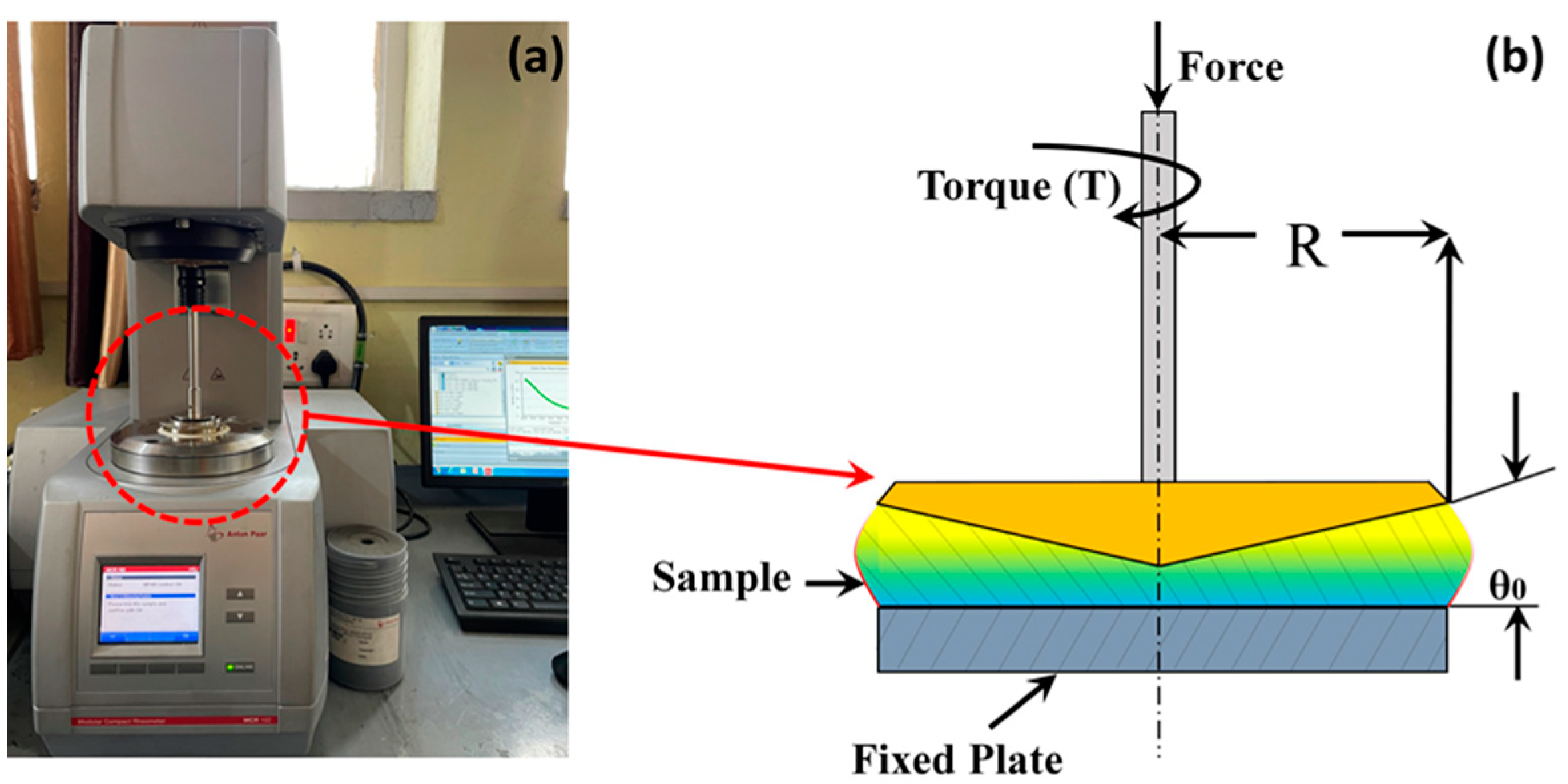

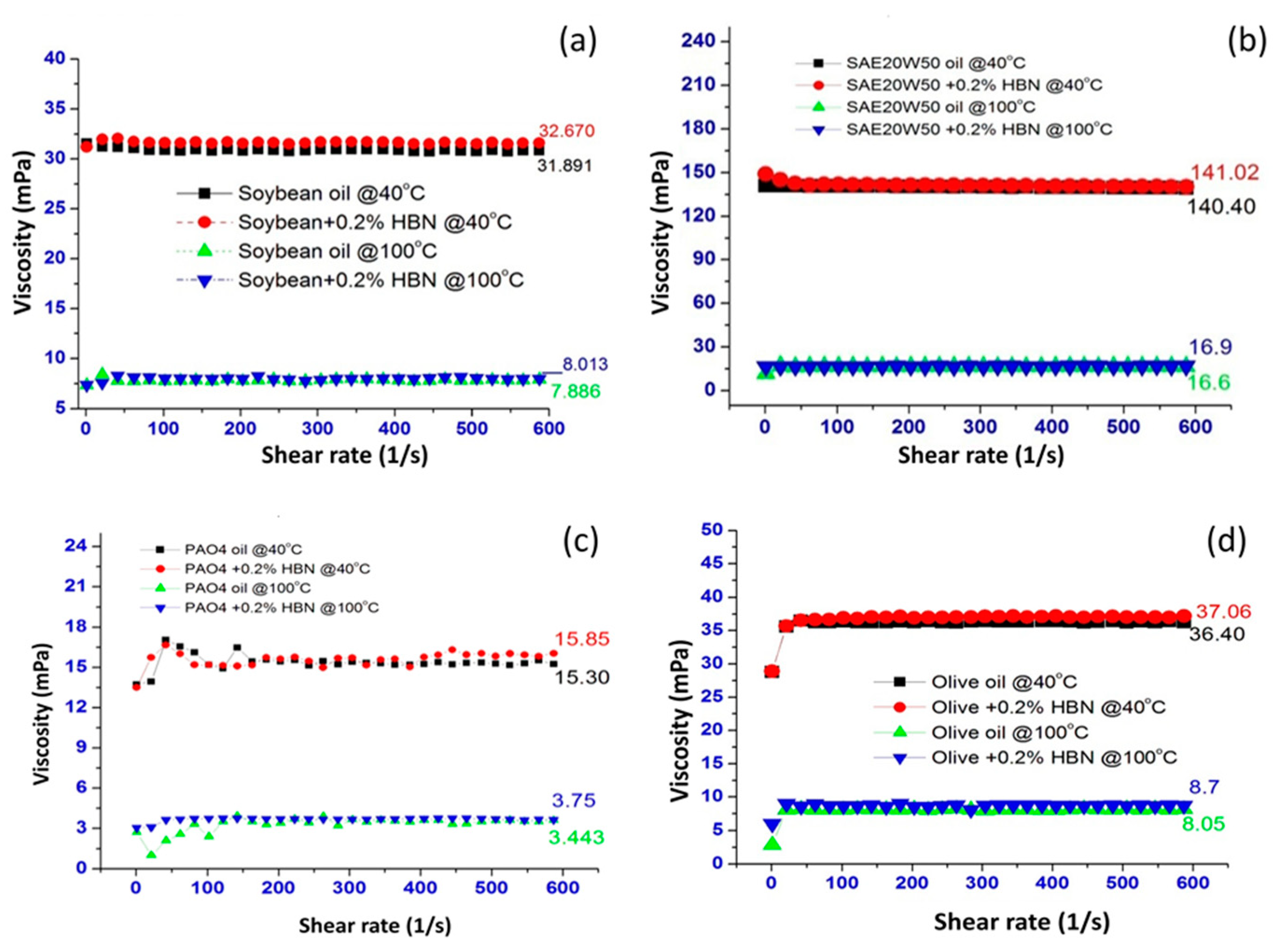

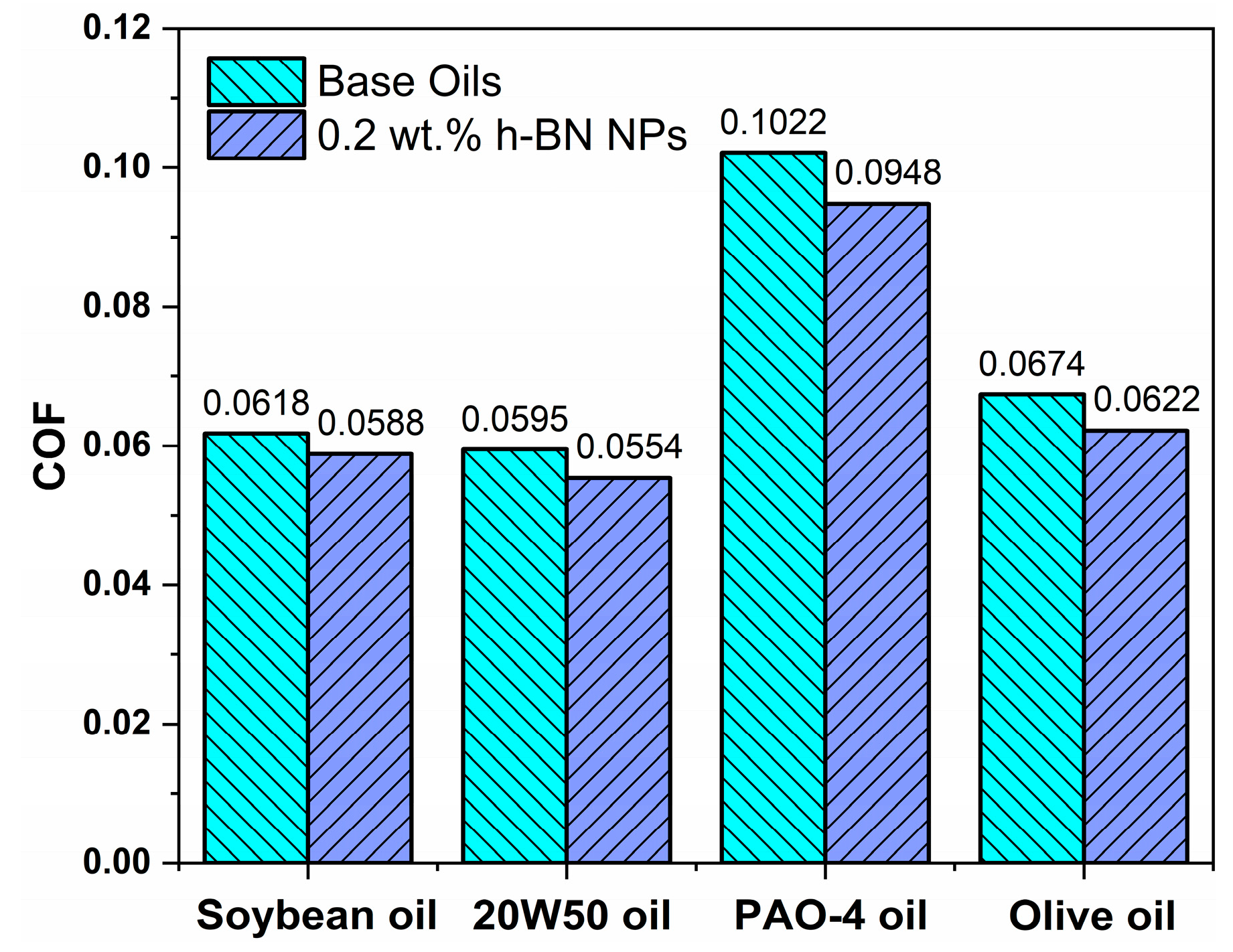
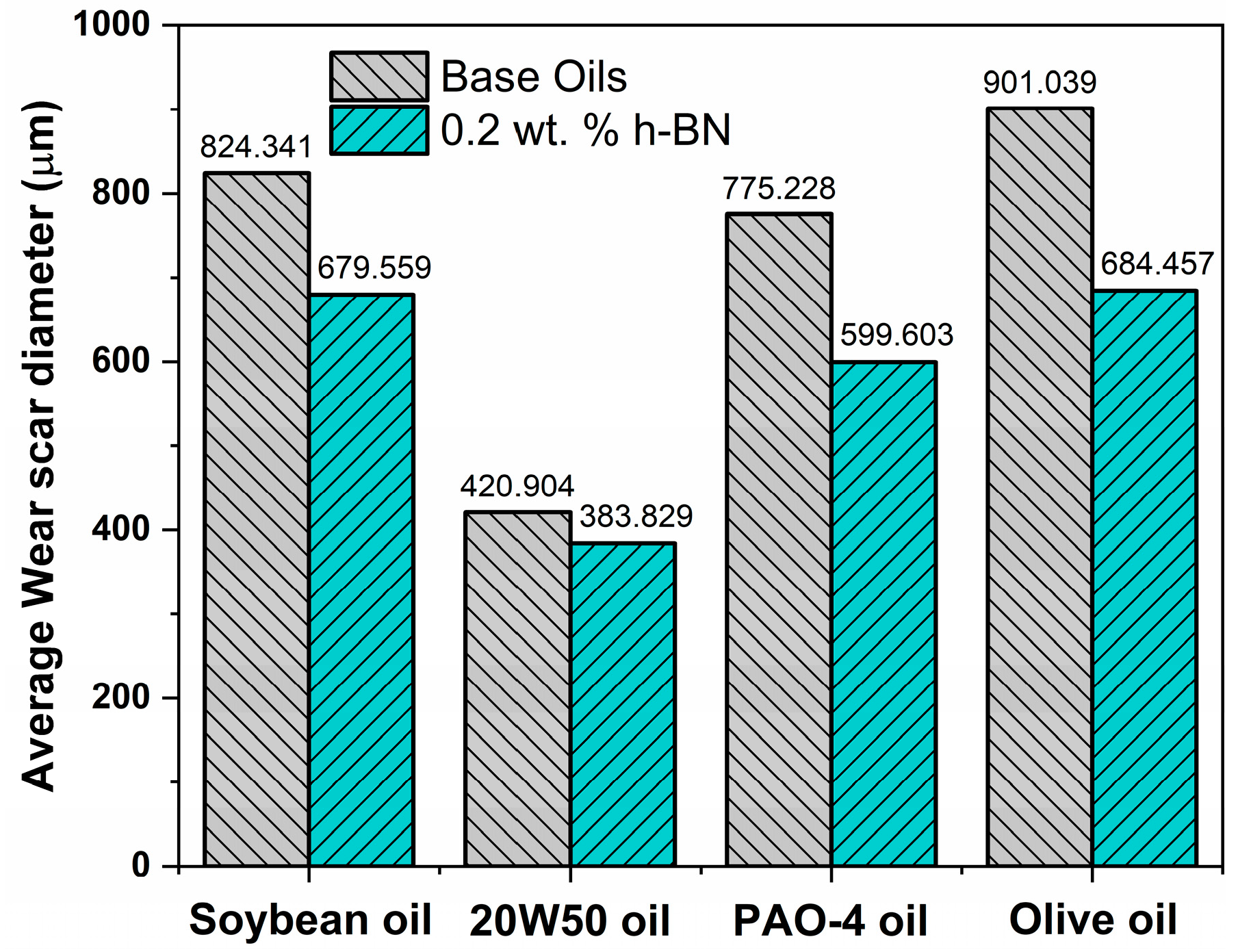
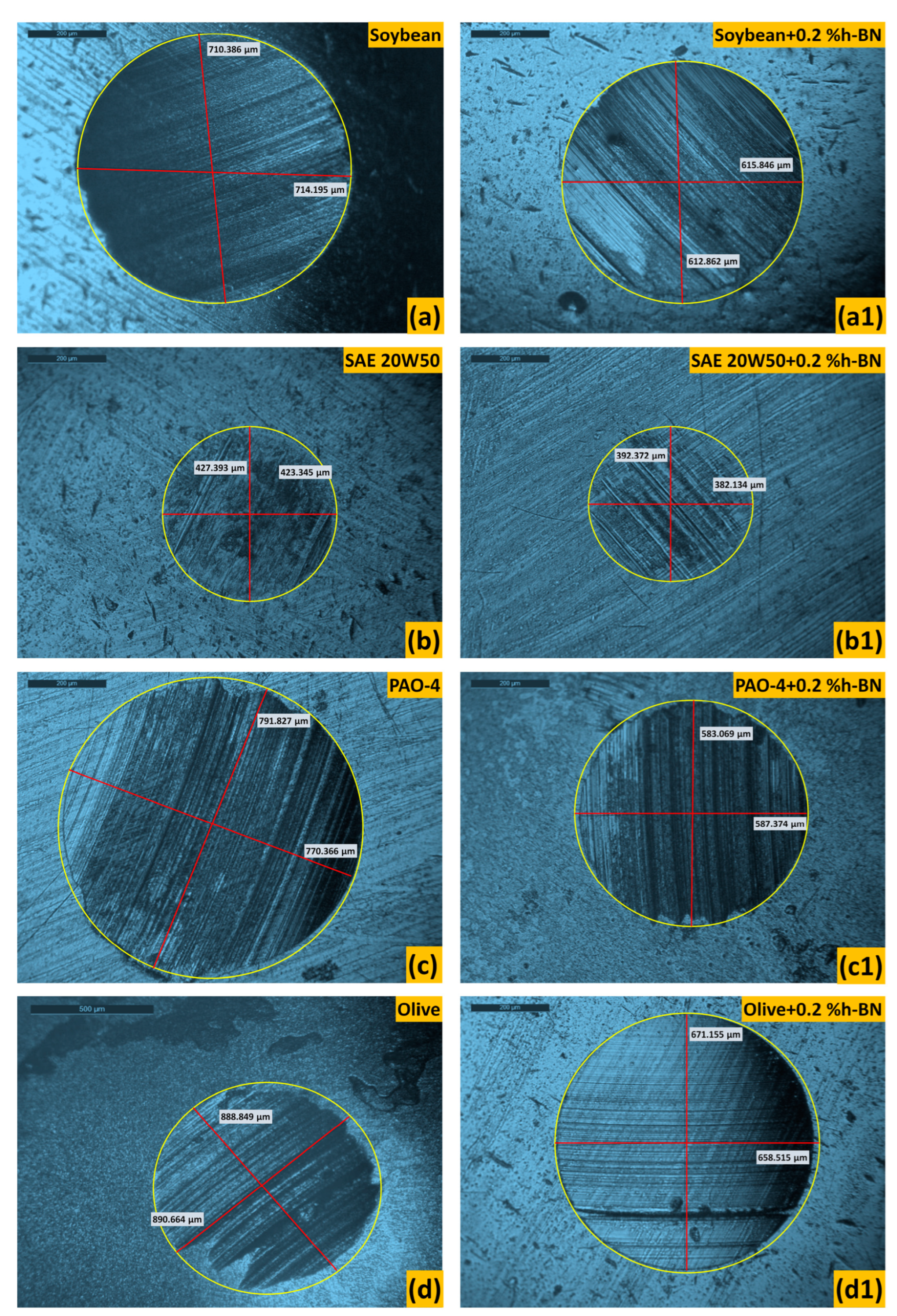




| Oil | Viscosity (m. Pas) at 40 °C | Viscosity (m. Pas) at 100 °C | Sp. Gravity |
|---|---|---|---|
| SAE 20W50 | 140.40 | 16.6 | 0.890 |
| Soybean Oil | 31.891 | 7.886 | 0.917 |
| PAO4 | 15.30 | 3.443 | 0.68 |
| Olive Oil | 36.40 | 8.05 | 0.913 |
| S. No | Test Parameters | Test Sample |
|---|---|---|
| 01 | Load—392 N Speed—1200 rpm Temperature—75 °C | Soybean Oil |
| 02 | Soybean Oil and 2 wt.% of h-BN | |
| 03 | SAE 20W50 oil | |
| 04 | SAE 20W50 and 2 wt.% of h-BN | |
| 05 | PAO4 oil | |
| 06 | PAO4 and 2 wt.% of h-BN | |
| 07 | Olive oil | |
| 08 | Olive oil and 2 wt.% of h-BN |
| Oil/Average Wear Scar Diameter (µm) | Ball 1 | Ball 2 | Ball 3 | AWSD (µm) |
|---|---|---|---|---|
| Soybean Oil | 900.96 | 712.290 | 859.77 | 824.341 |
| Soybean Oil and 2 wt.% of h-BN | 719.168 | 614.354 | 696.156 | 676.559 |
| SAE 20W50 oil | 425.369 | 418.672 | 418.513 | 420.904 |
| SAE 20W50 and 0.2 wt.% of h-BN | 376.980 | 387.253 | 387.260 | 383.829 |
| PAO4 oil | 781.096 | 791.353 | 753.205 | 775.24 |
| PAO4 and 2 wt.% of h-BN | 605.516 | 608.017 | 585.26 | 599.603 |
| Olive oil | 931.90 | 881.452 | 889.756 | 901.039 |
| Olive oil and 0.2 wt.% of h-BN | 664.835 | 723.70 | 664.835 | 684.457 |
Disclaimer/Publisher’s Note: The statements, opinions and data contained in all publications are solely those of the individual author(s) and contributor(s) and not of MDPI and/or the editor(s). MDPI and/or the editor(s) disclaim responsibility for any injury to people or property resulting from any ideas, methods, instructions or products referred to in the content. |
© 2024 by the authors. Licensee MDPI, Basel, Switzerland. This article is an open access article distributed under the terms and conditions of the Creative Commons Attribution (CC BY) license (https://creativecommons.org/licenses/by/4.0/).
Share and Cite
Ziyamukhamedova, U.; Wasil, S.; Kumar, S.; Sehgal, R.; Wani, M.F.; Singh, C.S.; Tursunov, N.; Gupta, H.S. Investigating Friction and Antiwear Characteristics of Organic and Synthetic Oils Using h-BN Nanoparticle Additives: A Tribological Study. Lubricants 2024, 12, 27. https://doi.org/10.3390/lubricants12010027
Ziyamukhamedova U, Wasil S, Kumar S, Sehgal R, Wani MF, Singh CS, Tursunov N, Gupta HS. Investigating Friction and Antiwear Characteristics of Organic and Synthetic Oils Using h-BN Nanoparticle Additives: A Tribological Study. Lubricants. 2024; 12(1):27. https://doi.org/10.3390/lubricants12010027
Chicago/Turabian StyleZiyamukhamedova, Umida, Shah Wasil, Sanjay Kumar, Rakesh Sehgal, M. F. Wani, Chandra Shekhar Singh, Nodirjon Tursunov, and Himanshu Shekhar Gupta. 2024. "Investigating Friction and Antiwear Characteristics of Organic and Synthetic Oils Using h-BN Nanoparticle Additives: A Tribological Study" Lubricants 12, no. 1: 27. https://doi.org/10.3390/lubricants12010027
APA StyleZiyamukhamedova, U., Wasil, S., Kumar, S., Sehgal, R., Wani, M. F., Singh, C. S., Tursunov, N., & Gupta, H. S. (2024). Investigating Friction and Antiwear Characteristics of Organic and Synthetic Oils Using h-BN Nanoparticle Additives: A Tribological Study. Lubricants, 12(1), 27. https://doi.org/10.3390/lubricants12010027






